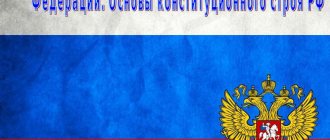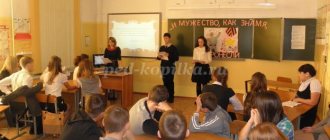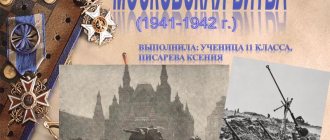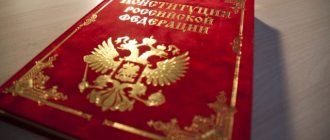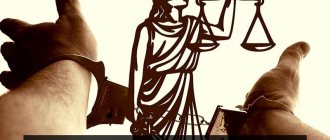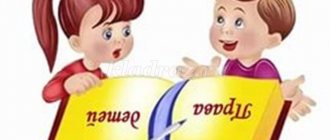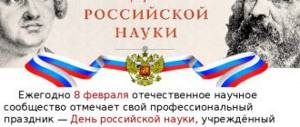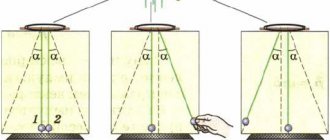Class hour for Constitution Day with presentation, 2nd grade
Class hour “Through the pages of the Constitution”
Goal: formation of patriotism Objectives: 1) get acquainted with the basic law of the country 2) develop the creative abilities of students 3) cultivate love for the Motherland. Equipment: presentation, crossword puzzle Slide 1 (Our Motherland)
— Today we will talk about the Russian national holiday.
Our Motherland is Russia, or the Russian Federation. There are many countries on our planet. There are large ones, and there are also very tiny ones. Every person, being a citizen of one state or another, is proud of his Motherland, loves it, and tries to do everything possible to make it even richer and more beautiful. And although you are still children, you are already citizens of a large and powerful state, whose name is Russia. Slide 2
- Guess the proverb: “Mother, man, one, Motherland, y, one, and.” (Work in pairs)
Slide 3 “A person has one mother, one homeland”
-How do you understand it?
-What other proverbs do you know about the Motherland? (“There is no more beautiful country in the world than our Motherland”, “On someone else’s side you are happy with your little raven”, “One’s own side is a mother, someone else’s is a stepmother.” What is the concept of “Motherland” for you? -Let’s listen to the poem about the Motherland (A. Prokofiev “Native Side”): 1) In the wide expanse of the pre-dawn time Scarlet dawns rose above the native land. 2) Dear lands become more and more beautiful every year. There is nothing better in the world than our homeland, friends! 3) Russia...Like a word from a song... Young birch trees, The hum of a factory floor, Our favorite city is Moscow. Slide 4
-Let's sing the Russian anthem. (Children standing perform the Russian anthem). -What feeling did you have? -The anthem is one of the symbols of the state. What other symbols are you familiar with? (Flag, coat of arms).
Slide 5
- Now we will solve a crossword puzzle about symbolism and find out the name of the class hour. (Work in groups) 1) The color of the bottom stripe on the flag. (Red) 2) The bird depicted on the coat of arms. (Eagle) 3) Solemn state song. (Anthem) 4) The color of the middle stripe on the flag. (Blue) 5) The rod is a symbol of power. (Scepter) 6) The name of the warrior depicted on the coat of arms of Russia and the city of Moscow. (George) 7) The Tsar-father of the Russian flag, who approved it as a trade one. (Peter) The eagle has two heads, which means it is... (Two-headed) 9) Our state is Russian... (Federation) 10) George, a warrior on a horse is... (rider)
(Work in groups) 1) The color of the bottom stripe on the flag. (Red) 2) The bird depicted on the coat of arms. (Eagle) 3) Solemn state song. (Anthem) 4) The color of the middle stripe on the flag. (Blue) 5) The rod is a symbol of power. (Scepter) 6) The name of the warrior depicted on the coat of arms of Russia and the city of Moscow. (George) 7) The Tsar-father of the Russian flag, who approved it as a trade one. (Peter) The eagle has two heads, which means it is... (Two-headed) 9) Our state is Russian... (Federation) 10) George, a warrior on a horse is... (rider)
Slide 6
— Read the keyword vertically: Constitution.
What is the Constitution? (This is the basic law of the state) This year the Constitution of the Russian Federation turns 22 years old. Our class hour is dedicated to this event and it is called “Through the Pages of the Constitution.” — Try to formulate goals and objectives. (Acquaintance with the basic law of the country, some of its articles) - Why do you need to study the Constitution? — This is the 8th Constitution of Russia, it was adopted by popular vote on December 12, 1993, and the first one appeared in 1918. — Read the beginning and tell me what is the main value of our state? Slide 7
“We are the multinational people of the Russian Federation, united by a common destiny on our land...” (The people, their rights and freedoms appear).
-The first section includes 9 chapters and consists of 137 articles, which contain fundamental rights and freedoms of the individual, the structure of the state, etc. There is a chapter dedicated to the president. Who is the President of the Russian Federation? Slide 8 (V.V. Putin)
So let's look through this book.
Slide 9
Art.
20. “Everyone has the right to life.” -How do you understand it? In which works is this right violated? Slide 10 (“The Wolf and the Seven Little Goats,” “Kolobok”)
Slide 11 Art. 25. "Home is inviolable"
— In which work is this right violated?
Slide 12 (“The Three Little Pigs”)
Slide 13
Art.
37. “Labor is free. Everyone has the right to freely use their ability to work, choose their type of activity and profession.” -Tell me what you want to become in the future. -No matter who you become, your work will benefit other people. Listen to poems about people of different professions (D Rodari 1) The man who built my house was a stranger, he was not familiar to me. But, sitting down tiredly on the porch, he thought about the future tenant. 2) The one who sewed the shirt for me was not a friend and not at all a relative, but even he, wielding a needle, sometimes thought about me. 3) I have never met anyone anywhere who made my shoes. But when he was alone, he often thought about me. In chorus : How many of them are there, friends in my country, That they remember me all the time! -What professions are people talking about in this poem? You must respect people's work. Give examples. Now let's listen to a poem about caring for bread: 1) Bread is ruddy and fragrant... What is better than bread in the world? There is no tastier loaf in the whole world! 2) We buy it in the store very cheaply. Only there is a different price for a simple loaf. 3) We must not forget that it comes with hard work! The work of a breadwinner is very difficult! Slide 14
Art.
43 “Everyone has the right to education” - All of you are 2nd grade students. Then you will go to 3rd grade, 9th grade, and someone will want to finish 11th grade. After graduating from school, you will continue to receive education in colleges, technical schools, and institutes. School is the first step in education, but undoubtedly a very important one. Tell me what they teach at school. Let's do a song about this. (Song “What They Teach at School”) Slide 15
Art.
58 “Everyone has a responsibility to preserve nature and the environment.” -Let's listen to the poem (Metreveli M. “The Earth is our home”): 1) You may be surprised to learn, - The Earth is our home! Animals and birds live in it, and you and I live. 2) The earth is our huge house, There are many floors in it For underwater inhabitants And for forest snakes. 3) There was enough for all the apartments: For buffalos and goats, For owls and crocodiles, For hares and dragonflies. 4) The earth is our huge house And even if it was not built from concrete slabs, But that’s not the point at all. 5) And the fact is that we are neighbors, and we must save deer and bears, this is what we are talking about! -How should we treat nature? Slide 16
Art.
59 “Defense of the Fatherland is the duty and responsibility of a citizen of the Russian Federation” - A young man who has reached the age of 18 and has no contraindications for health reasons is drafted into the ranks of the Armed Forces of the Russian Federation. They serve in the Navy, in the airborne, missile, and tank forces, and guard our borders. Now the poem by O. Vysotskaya “My brother went to the border” will be read. 1) My brother went to the border, He is a border guard. He's a soldier. When we are fast asleep at home, my brother goes on night watch. 2) He goes into the darkness of the night and takes a machine gun with him. He takes care of his native country, he takes care of his native family. 3) He hears the quietest rustle, He notices every trace. In the deep forests, in the steppe expanses - There is no way for enemies anywhere! 4) He won’t return home soon, He won’t hug us soon. But I know that somewhere on the border he is thinking about us now! -Which of you, boys, wants to defend our Motherland? - Let's sum it up . What is the Constitution? Why do we need to know the fundamental law of the land? Imagine the situation if this law did not exist, there would be no rules and regulations? Now you are small citizens of Russia, but you also have rights, you also have your responsibilities. Name them. And your most important responsibilities are to love your homeland, study well, and behave correctly in society. In conclusion, let’s listen to a poem about the rules of behavior (S. Marshak “A Lesson of Politeness”) A bear of five or six years old was taught how to behave: - When visiting, bear, You must not roar, You must not be rude and arrogant, You must bow to your acquaintances, You must take off your hat to them , Don’t step on paws, And don’t catch fleas with your teeth, And don’t walk on all fours. There is no need to slurp and yawn, but whoever yawns to his heart’s content must cover his gaping mouth with his paw. Be obedient and be polite. And give way to passers-by. And respect the old. And see the grandmother bear home in the fog and ice. So a bear of five or six years old was taught how to behave... Although he became polite in appearance, he remained bearish. He bowed to his neighbors - foxes and bears, gave up his place to acquaintances, took off his hat to them, and stepped on the paw of strangers with his entire heel. He stuck his nose where it shouldn’t, trampled the grass and crushed oats, leaned on his belly on the public in the subway, and threatened to break a rib for old men and old women. A bear of five or six years old was taught how to behave. But, apparently, the teachers were wasting their time! -What rules are talked about in this poem? (About the rules of behavior in society) Summing up, reflection. -What is the name of the basic law of the country? -Why is it necessary to study it? - Analyze your work. -I was interested... -I need to know this because... -It is not necessary to know... Literature: “The Constitution of the Russian Federation” Vysotskaya O. “My brother went to the border.” Marshak S. “A Lesson of Politeness” Metreveli M. “The Earth is Our Home” Prokofiev A. “Native Side” Crossword Appendix 1 ) The color of the bottom stripe on the flag. 2) The bird depicted on the coat of arms. 3) Solemn state song. 4) The color of the middle stripe on the flag. 5) The rod is a symbol of power. 6) The name of the warrior depicted on the coat of arms of Russia and the city of Moscow. 7) The Tsar is the father of the Russian flag, who approved it as a commercial one. The eagle has two heads, which means he... 9) Our state is Russian... 10) George, a warrior on a horse is...
2) The bird depicted on the coat of arms. 3) Solemn state song. 4) The color of the middle stripe on the flag. 5) The rod is a symbol of power. 6) The name of the warrior depicted on the coat of arms of Russia and the city of Moscow. 7) The Tsar is the father of the Russian flag, who approved it as a commercial one. The eagle has two heads, which means he... 9) Our state is Russian... 10) George, a warrior on a horse is...
Presentation on the topic: Our Motherland - Russia
We recommend watching:
Intellectual-cognitive game in elementary school. Constitution of the Russian Federation Intellectual game for Constitution Day, 4th grade Extracurricular activity for Constitution Day, 3rd grade. Notes with presentation Event for Constitution Day for primary classes. Presentation script
Similar articles:
Extracurricular activity for Constitution Day in primary school
Class hour on the pages of the Constitution of the Russian Federation (2nd grade)
Topic: Through the pages of the Constitution of the Russian Federation
Target:
— introduce students to the basic law of the state - the Constitution of the Russian Federation;
Tasks:
— promote the development of cognitive activity of students;
- to form humanism, a comprehensively developed personality;
— to cultivate a sense of pride and respect for the Motherland and the Constitution.
Equipment: board, handouts, presentation, projector, computer.
PROGRESS OF THE CLASS HOUR
I. Org. moment
— Greeting “Hello!”
Students take turns touching the fingers of the same name on their neighbor’s hands, starting with the thumbs, and say:
- I wish (thumbs touching);
- success (index);
- large (medium);
- in everything (nameless);
- and everywhere (little fingers);
- Hello! (touch with whole palm)
- Good afternoon guys!
- We have guests today. Let's greet them, give them our smiles and good mood. Have a seat.
II. Updating knowledge
- Guys! Tell me, please, what is significant about December 12th in our country?
- Today we will try to find the answer to this question.
III. Learning new material
- I suggest you listen carefully to the fairy tale and think about why the country of Law became prosperous?
“Once upon a time there were two states: It is possible and it is not possible. They lived according to different laws. In the State of Possibility, everything was allowed. Adults could not go to work - factories, schools, and hospitals were not working well. Children went to school as they wished. Anyone could have offended them. People could take other people's things without permission, they could offend each other and be rude. The streets of the city were dirty and uncomfortable.
In the state it was impossible that everything would be completely different. In this state, all adults went to work, so factories, schools, hospitals, and shops worked. It was impossible to be rude to the townspeople. Children eagerly went to school and kindergartens. Nobody had the right to offend them.
These two states were constantly at odds with each other. And then the day of the decisive battle came. The battle was won by the army of the state. It captured half of the state. It is impossible. What started here!
In the cities and villages of the former state, it was impossible to steal, to offend each other with impunity, and robbers ruled the roads. The state of Mozhno has fallen into decay. And then the rulers of the state It is possible asked for help from the state It is impossible. They consulted for a long time and came to the decision to unite and create a new state of Law. The rulers of the city agreed on what people have the right to and what they do not, and what duties they must perform. And the result of such work was the fundamental law of the state. Order was established in the state, and all residents became happy and contented.
Teacher: - So, why do you guys think the country became prosperous, all the inhabitants became happy and contented, and why did they feel safe? (Residents began to live according to the laws.)
- Yes. A basic law was adopted in this state. We will find out what it is called by solving the crossword puzzle.
(Front work)
1) The color of the bottom stripe on the flag. (Red)2) The bird depicted on the coat of arms. (Eagle)3) Solemn state song. (Anthem)4) The color of the middle stripe on the flag. (Blue)5) The rod is a symbol of power. (Scepter)6) The name of the warrior depicted on the coat of arms of Russia and the city of Moscow. (George)7) The Tsar is the father of the Russian flag, who approved it as a commercial one. (Peter)8) The eagle has two heads, which means it is...(two-headed)9) Our state is the Russian...(Federation) 10) George, a warrior on a horse is...(rider) 11) The main symbol of the army (Znamya).
— Read the keyword vertically: Constitution.
— This is the name of the basic Law of many states. Translated from Latin, this word means to affirm, to establish.
The Constitution determines what rules people should live by: what can and should be done, and what is prohibited.
- Who came up with all these rules? We will try to find out about this by opening the first page of the Constitution, which is on your desks. Try to understand WHO developed and adopted this Law. (Work in pairs. Children's answers).
- Well, of course, the people themselves. It was developed on the basis of international documents establishing human rights.
1948 – Universal Declaration of Human Rights;
1950 – European Convention for the Protection of Human Rights and Fundamental Freedoms;
1959 – Declaration of the Rights of the Child;
1989 – Convention on the Rights of the Child.
— The day of adoption of the Constitution is considered a memorable date and is a public holiday. When was the Basic Law of the Russian Federation adopted? (Children find the date of adoption in the Constitution).
- Yes, in our country this happened on December 12, 1993 (Writing on the board). And today marks its 25th anniversary. In honor of this event, a 25 ruble coin was issued.
— In order for every citizen of the country to be able to study the laws well, the Constitution was published in the form of a book. Let's look at its contents (first page). It consists of 2 sections, chapters and articles. (Show). Here we can also find all the information about the main symbols of our country.
“When you grow up, you will read it all, but today we will only look at some pages.” Try to formulate the topic of the lesson.
— What would you like to learn about in class?
— Today we will only talk about what is written in the Constitution about the rights of citizens, incl. and children. Although you are small, you have already been citizens of our country since birth.
- How do you understand what law is? (Children's answers)
— Yes, law is the rules by which people live. They determine the relationships of people in society. These rules are protected by the state. The Constitution contains the rights of our citizens. Open page 8, chapter 2 (bookmark). There are 48 articles in this chapter, but we will look only at those articles that protect not only the rights of adults, but also children.
- Guys! Now you, working in pairs, read the indicated article and name the law. We will create a cluster that will help us remember our rights - p. 20, 23, 26, 28, 29.1, 37.5,38,41.1,43.1
(Children call - the teacher posts the rule on the board.
Rights: to life, to privacy, to use one’s native language and choice of religion, to freedom of thought and speech, to rest, to family upbringing, to housing, to health care and medical care, to education).
- How many rights! In addition to rights, Russian citizens also have responsibilities, which are also reflected in the Basic Law. But we'll talk about them next time.
- And now I suggest you rest
IV. Physical education minute
V. Consolidation of the studied material
— To consolidate the acquired knowledge, I offer you a fabulous quiz. To do this, you must divide into groups. On the table everyone has a fragment of an illustration for a fairy tale. You must collect it, review it, determine its name and answer the questions. All assignments are in your envelope. (Children choose one of the two proposed rights, stick it on the illustration and defend their choice, and the rest express their agreement or disagreement using signal cards).
"The Ugly Duckling" by G.H. Andersen
-Whose rights were violated in this fairy tale? (The ugly duckling)
- What right was violated? (For privacy)
“Sister Alyonushka and brother Ivanushka” b. With.
—What right did the witch violate in this fairy tale? (Right to life and liberty, right to own personal property).
—Whose other rights were violated in this fairy tale? (Brother’s rights to protection and right to family were violated)
"The Fox and the Hare" r.s.
— What right is being violated in this illustration? (The right to non-
privacy of the home) - Who violated this right? (Fox) - Who protected the hare and helped him regain his rights? (Rooster)
A.N. Tolstoy. "The Golden Key or the Adventures of Pinocchio"
- What right did Buratino not take advantage of? (Right to education) - Who helped him cope with difficulties? (Malvina, Pierrot, ...)
K.I. Chukovsky. "Aibolit"
- Name the main characters of the fairy tale? (Aibolit, animals, robbers)
—What right did the robbers want to deprive the animals of? (Right to medical care).
Protecting responses
VI. Reflection
Individual work
Children choose one of three answers and write the letter of the answer in the column on the right. Whoever answers correctly should get the word WELL DONE.
Game “Determine which of the heroes of the fairy tale they wanted to deprive of the following rights” /choose one hero out of three/
| The right to live | A) Cinderella M) Kolobok C) Puss in Boots | M |
| Right to integrity dwellings | D) Sister Alyonushka O) Bunny B) Kolobok | ABOUT |
| Right to free work | L) Cinderella H) Little Red Riding Hood T) Balda | L |
| The right to own personal property | G) Little Red Riding Hood O) Pinocchio E) Baba Yaga | ABOUT |
| The right to live in a family with one's parents. | B) The Frog Princess D) The ugly duckling H) Gray wolf | D |
| The right to rest. | I) Fox Alice E) Tiny Khavroshechka H) Little Mouse | E |
| Right to medical care | R) Baba Yaga C) Animals from Africa C) Little Red Riding Hood | C |
- You are really great!
VIII. Summarizing
— So where are the rights and obligations of Russian citizens written down? (In the Basic Law
Russia – Constitution.)
— When was the new Constitution adopted? (December 12, 1993)
—What is the Constitution for? (Children's answers.)
— What rights are enshrined in the Basic Law of the Russian Federation? (Refer to cluster)
— Does the Constitution protect only the rights of children?
- Let's go back to our fairy tale. What helped the people of the state of Law to establish a quiet life? (Adoption of the Constitution)
- Guys! Did you find answers to your questions during the lesson?
— What needs to be done to answer the questions posed?
- Everything is correct! Our acquaintance with the basic law of our country will continue, and today the class hour is coming to an end, and I propose to read the following lines
The Constitution is the main right
For the one who is born into the world,
And strong and mighty power,
Holyly honoring this Law.
- Our class is over. Thank you for the lesson!

